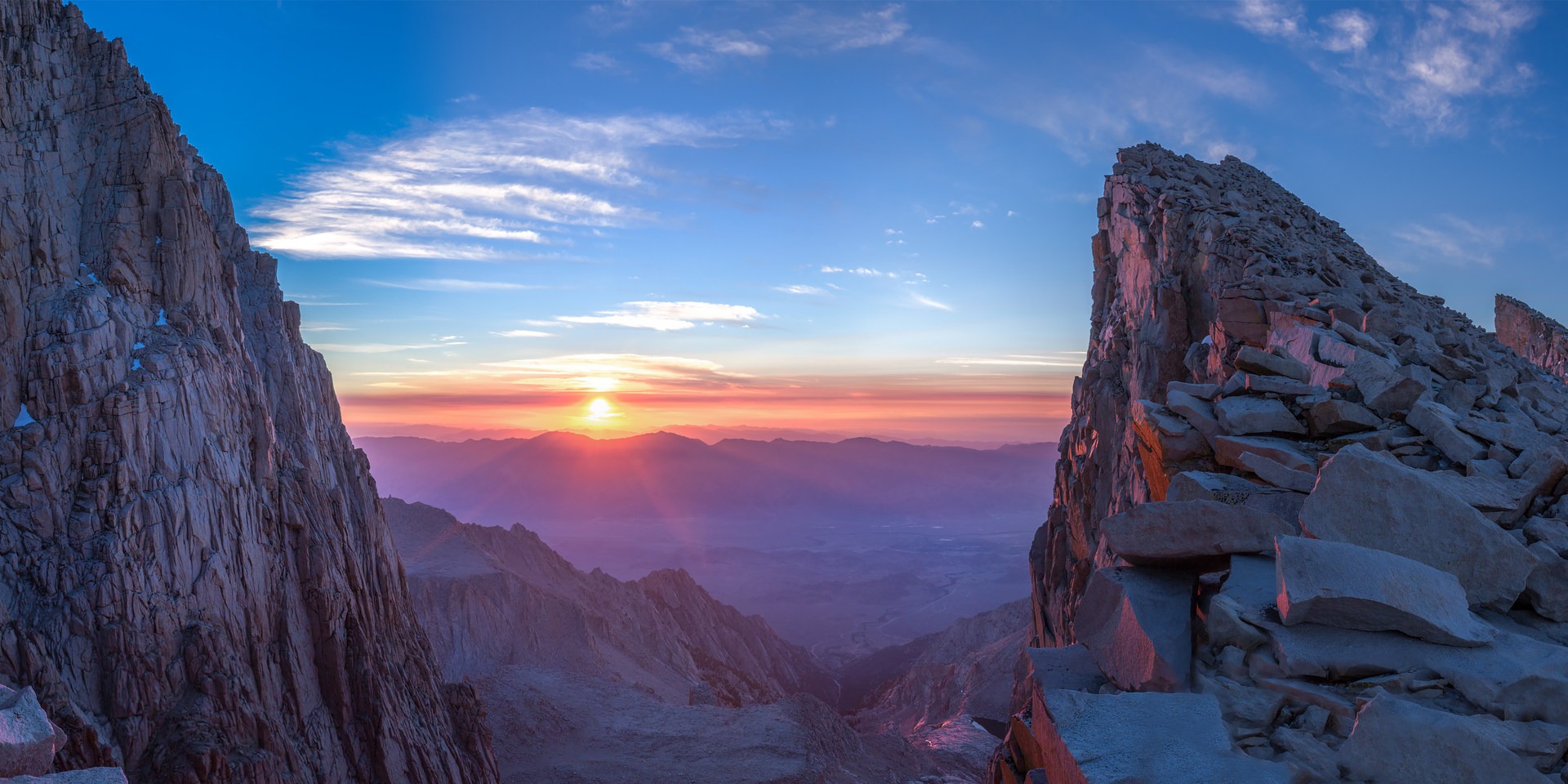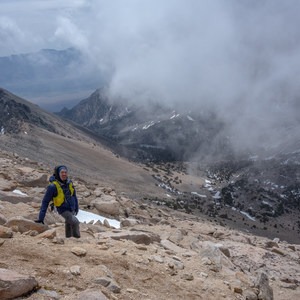You are here
Regarded by many as the premier hiking trail in the country, the John Muir Trail (JMT) runs along the backbone of California’s High Sierra between Yosemite National Park and the summit of Mount Whitney. The 211-mile long trail commemorates the influential naturalist and founder of the Sierra Club, John Muir, who’s understanding of the landscape and voice for conservation laid the groundwork for protecting much of the Sierra through the establishment of Yosemite, Kings Canyon and Sequoia national parks. The JMT can be done in segments or as a thru-hike, many opting for the latter. Pre-planning is critical to a successful JMT thru-hike; advance permits are required. Most hikers take around three weeks to complete the journey following the trail southbound (SOBO) from Yosemite Valley. See the John Muir Trail Overview for more information on logistics and permit information.
This final section of the JMT covers the southernmost 50 miles from the crossing at Woods Creek to the summit of Mount Whitney, heading north to south through the high country of Kings Canyon and Sequoia National Parks. While it’s difficult to say which section of the JMT is the most scenic, these final miles may be the most memorable given the beauty of places like the Rae Lakes Basin, the climb up and over the trail’s highest pass, and the termination of the JMT at the summit of Mount Whitney, the tallest point in the contiguous United States. Like the rest of the trail, fishing can be decent among the lakes and provide a welcomed opportunity for freshly cooked trout, but mosquitoes can also be a nuisance. Big high elevation gains await JMT hikers in the climbs over Forester Pass and up Mount Whitney, but by this time most will have acclimated well and built up the strength to surmount these climbs like the passes that came before. That said, 14,505-foot Mount Whitney is a significant endeavor, and the altitude may pose challenges for some.
Heading south from the Woods Creek suspension bridge crossing, the JMT follows the South Fork of Woods Creek up 2,000 feet to Dollar Lake, a lake with decent fishing and that marks the beginning of Rae Lakes Basin. The Rae Lakes area is considered one of the most picturesque sections of the JMT, where electric blue-hued lakes are backed by highly featured and glacially carved peaks bearing names such as Fin Dome and Painted Lady. This is a popular, high-use section of trail with multi-day hiking parties accessing the Rae Lakes Loop from the trailhead at Road's End to the west and via Baxter and Kearsarge Passes to the east. A backcountry ranger station is located at Rae Lakes, as are bear boxes and lots of bears. Note that camping is restricted to one night between Woods Creek and Glen Pass for JMT hikers.
Once beyond Rae Lakes, JMT hikers climb to 11,980-foot Glen Pass. Be advised that Glen Pass is often holding snow well into July and can have an icy north aspect. From Glen Pass the JMT drops down to Vidette Meadow and the junction with the Bubbs Creek Trail/Rae Lakes Loop, passing by the Charlotte Lake (the location of another backcountry ranger station) and the Bullfrog Lake/Kearsarge Lakes/Kearsarge Pass trail junctions. This latter junction is important to note as it marks the trail to Onion Valley, a common final resupply point via Kearsarge Pass. Resupplying at Onion Valley adds 15 miles to the trip and needs to be coordinated by family or friends. This is most typically organized through Mount Williamson Motel in Independence through a donation that supports the Sierra Nevada Bighorn Sheep Foundation. There is also a horsepacking service that operates out of Onion Valley that can meet parties on the trail.
Continuing south from Vidette Meadow, the JMT follows Bubbs Creek and passes the junction for Center Basin before continuing up a broad U-shaped glaciated canyon and beginning the long climb toward Forester Pass. At 13,200 feet, Forester Pass is the second-highest point on the JMT after Mount Whitney. Snow and ice are often encountered on this pass, and the south side is fairly steep. Forester Pass also marks the border between Kings Canyon and Sequoia National Parks, and the remaining miles south of here lie within Sequoia National Park.
From Forester Pass the JMT descends into a broad valley between Diamond Mesa and Caltech Peak, through which Tyndall Creek flows. The trail crosses Tyndall Creek near 11,000 feet, which is also the junction with Tyndall Creek Ranger Station and Shepard Pass, continuing south to cross the Bighorn Plateau. The open Bighorn Plateau provides contrasting scenery compared with the lake-studded basins and high alpine passes typical of the JMT, and it affords expansive views of the surrounding peaks of the High Sierra. Beyond Bighorn Plateau the trail continues south toward Wallace Creek and the junction of the High Sierra Trail, a 70-mile trail traversing the Sierra from west to east from the Giant Forest to Whitney Portal. The JMT and High Sierra Trail are one in the same from here south. Nice campsites are situated at Wallace Creek.
Beyond Wallace Creek the JMT climbs gradually and passes Sandy Meadow on it's way toward Crabtree Ranger Station. Crabtree is a popular spot for JMT, PCT, and HST hikers looking to rest up and acclimate before the high elevation climb up Mount Whitney. Others on a shorter timeframe choose to continue on up to Guitar Lake lying at 11,700 feet, which affords a jump on the alpine start for the final climb to Whitney’s summit. JMT hikers should make sure to pick up a WAG bag (a solid human waste pack-out kit) for carrying human waste off of Mount Whitney. Packing out all solid human waste is mandatory on Mount Whitney above Guitar Lake through to the Whitney Portal Trailhead.
From Guitar Lake, to reach the summit of Mount Whitney is a 5-mile hike that gains 2,800 feet of elevation. An early alpine start is highly recommend for two reasons: the first is that you'll want to catch the sunrise on the summit of Mount Whitney, a true life bucket list experience; the second is that afternoon thunderstorms and lighting strikes pose a significant risk on Mount Whitney and surrounding summits and should be taken seriously. The National Park Service recommends that all parties should be heading down from Whitney’s summit by 11 a.m. Above Guitar Lake, the JMT switchbacks up the Whitney Massif's boulder-strewn west aspect. The trail rises above Hitchcock Lakes and affords morning twilight views of Mount Russell and Mount Hitchcock. At the junction with Trailcrest, most hikers leave their large backpacks (close it up well to deter Marmots), taking a smaller bag and water to complete the final 2 miles to Whitney’s Summit. The Whitney Summit Trail passes under Mount Muir and through “The Windows” section of the Whitney Massif, opening up to views of the Eastern Sierra and Owens Valley below. At 14,505 feet, the summit of Mount Whitney is where the JMT terminates. Along with some of the finest views in the High Sierra, a summit register next to the storm shelter awaits for JMT hikers to leave their mark.
From Whitney’s summit it’s 11 miles and 6,000 feet of descent to Whitney Portal via Trail Crest. Most JMT hikers will make the full push from Guitar Lake down to Whitney Portal, but there is the option to camp at Trail Camp or Outpost Camp on the way down. Note that due to high use, both Guitar Lake and Trail Camp have been known to have sanitation issues. Make sure to filter water at these locations.
Whitney Portal is a welcomed site to most JMT hikers, offering a café, a small store and the option of a shower. This is where shuttle rides and pick-ups from family or friends return hikers to society, although a backpackers camp affords the option of another night under the stars at Whitney Portal should you wish to extend the experience just a little bit longer.
For additional trail details, refer to the following John Muir Trail sections:











Comments
Sign In and share them.